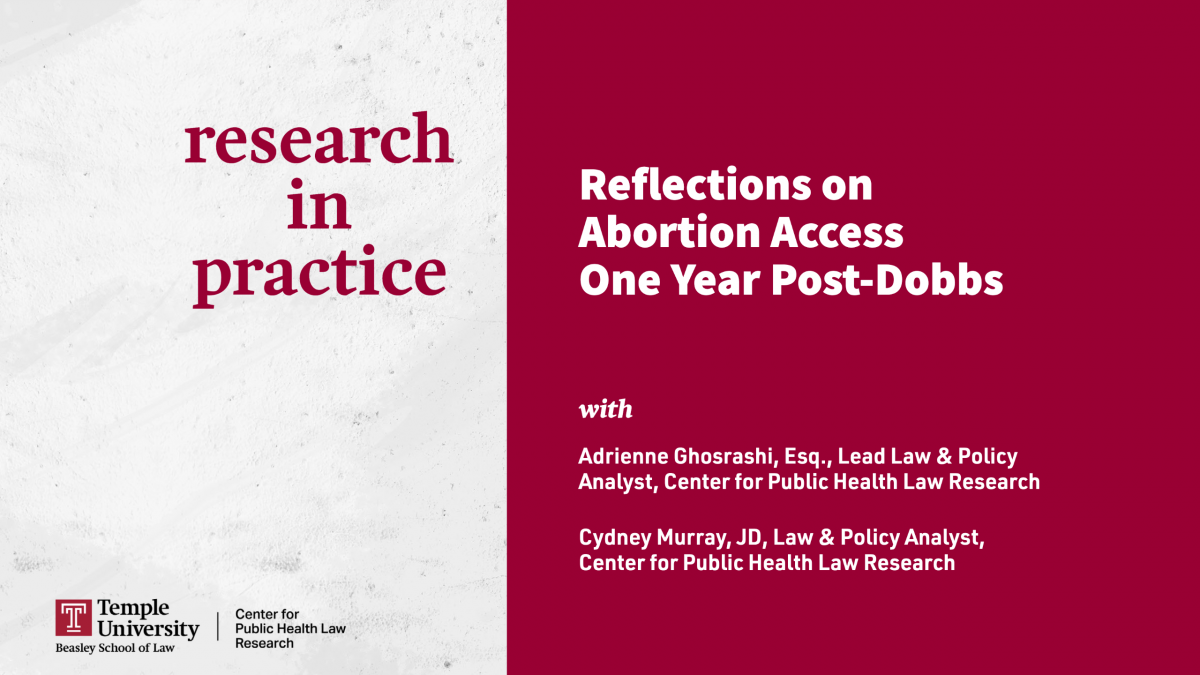June 24, 2023, marks one year since the US Supreme Court upended the limited constitutional protection of abortion afforded by Roe v. Wade. Now, the legal status of abortion varies even more drastically across the nation, compromising equitable access to this essential health care. While some states have moved to ban abortion outright, others have enacted measures attempting to protect and expand access.
Two CPHLR reproductive rights experts, Adrienne Ghorashi and Cydney Murray, sat down during the week of the anniversary to discuss the Dobbs decision, the changes it’s brought to the abortion landscape, the impact those changes are having on access, and how states have responded.
Adrienne and Cydney are part of the team working on the Center’s Post-Dobbs State Abortion Restrictions and Protections dataset, which is funded by the Society of Family Planning as a partner resource to its #WeCount project. The dataset was designed to track the complex and rapidly changing legal landscape of abortion throughout the year after Dobbs. Explore the data.
How did we get here?
While many may have thought of Roe v. Wade as a guarantee, in reality, it only provided a minimum level of protection. Abortion was highly restricted in many states before the Dobbs decision, and there were already many states with gestational limits, mandatory waiting periods, TRAP laws, and restrictions on medication abortion and telehealth, among other barriers to abortion. With the Dobbs decision, states are now permitted to ban abortion completely, or with exceedingly narrow exceptions.
Our Abortion Law Project captures state abortion laws across 16 domains, from December 1, 2018, through November 1, 2022, offering a comprehensive overview of the pre-Dobbs landscape.
How has state policy changed since the decision?
The biggest change was the number of total or near-total abortion bans that rapidly went into effect. The reason that abortion could be banned overnight in some states was because of “trigger bans” (laws banning abortion that were set to go into effect as soon as Roe was overturned) and pre-Roe abortion bans that were unenforceable under Roe but were never technically repealed. When Dobbs was decided last year, these previously unconstitutional abortion bans suddenly became legally enforceable.
Adding to the chaotic landscape those rapid changes have created are the litigation battles over whether these extreme bans should be allowed to take effect.
Legislatures are also moving to restrict access to abortion pills and telehealth for abortion in an effort to block people from receiving the care they need without having to travel across state lines.
What does this mean for people trying to access care?
For many people, access was already limited, but this decision has decimated what may have been left. Longer wait times at clinics, increased distances to travel for an appointment, trouble finding childcare, — all of this translates to higher out-of-pocket costs. The communities most impacted are those already marginalized: people who have low incomes, people who are in rural communities, people who are BIPOC and gender expansive, and young people. It’s also affecting the quality of other reproductive health care, as providers struggle to understand the law.
There has also been an increasing concern around the criminalization of abortion, which has a chilling effect on providers who may fear prosecution and other legal actions, helpers who provide access to funds and practical support networks, and abortion patients themselves.
How are states attempting to counter other states’ abortion bans and restrictions?
It’s not all bad news! There are now 17 states with interstate “shield laws” that aim to shield patients, providers, and helpers from out-of-state civil liability or criminal penalties related to abortion care that is legal in the state where care is received.
Three states — California, Michigan, and Vermont — approved ballot measures amending their constitutions to protect the right to abortion, while voters in Kansas, Kentucky and Montana rejected efforts to restrict abortion. Additionally, 18 states have codified the right to an abortion under state law. Read more about how states have responded.
Looking ahead, what are we watching out for in the next year?
We anticipate a few key areas of legal developments (among many others): first, we’re watching the ongoing legal battles concerning state bans on abortion, like those in Florida and Georgia. The outcomes of these cases largely determine the extent to which a ban will be enforced.
Second, there are emerging creative policy solutions to protect and improve access to care — like interstate shield laws. We will be watching to see how those develop and how and where other novel solutions emerge.
Finally, in both restrictive and protective states, we’re carefully tracking how lawmakers are designing policies around medication abortion, telehealth, and self-managed abortion, especially as legal battles around mifepristone, one of the most commonly used abortion pills, continue to unfold both in federal and state courts.
Continued tracking of these laws remains essential. Our next update to the post-Dobbs dataset will be released in July 2023.

